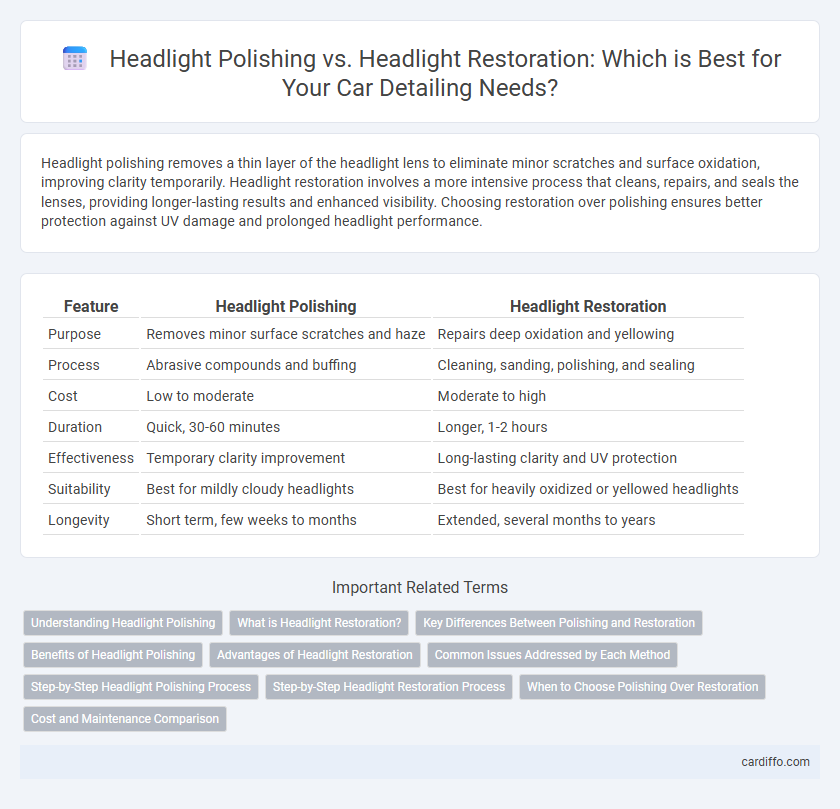Headlight polishing removes a thin layer of the headlight lens to eliminate minor scratches and surface oxidation, improving clarity temporarily. Headlight restoration involves a more intensive process that cleans, repairs, and seals the lenses, providing longer-lasting results and enhanced visibility. Choosing restoration over polishing ensures better protection against UV damage and prolonged headlight performance.
Table of Comparison
| Feature | Headlight Polishing | Headlight Restoration |
|---|---|---|
| Purpose | Removes minor surface scratches and haze | Repairs deep oxidation and yellowing |
| Process | Abrasive compounds and buffing | Cleaning, sanding, polishing, and sealing |
| Cost | Low to moderate | Moderate to high |
| Duration | Quick, 30-60 minutes | Longer, 1-2 hours |
| Effectiveness | Temporary clarity improvement | Long-lasting clarity and UV protection |
| Suitability | Best for mildly cloudy headlights | Best for heavily oxidized or yellowed headlights |
| Longevity | Short term, few weeks to months | Extended, several months to years |
Understanding Headlight Polishing
Headlight polishing involves mechanically buffing the outer layer of the headlight lens to remove surface oxidation, minor scratches, and cloudiness, restoring clarity and brightness. This process typically uses fine abrasives and polishing compounds, which can significantly improve light output without replacing the headlight assembly. Understanding headlight polishing is essential for maintaining vehicle safety and aesthetics, especially when lenses exhibit superficial wear rather than deep damage or yellowing.
What is Headlight Restoration?
Headlight restoration involves removing oxidation, yellowing, and surface imperfections from plastic headlight lenses to improve clarity and brightness. This process typically includes sanding, polishing, and applying a protective sealant to restore the lens to near-original condition. Unlike polishing, restoration addresses deeper damage and extends the lifespan of headlights by preventing further degradation.
Key Differences Between Polishing and Restoration
Headlight polishing involves removing surface oxidation and minor scratches from the lens using abrasive compounds to improve clarity, while headlight restoration entails a comprehensive process including cleaning, sanding, and applying protective coatings to fully renew and seal the headlight. Polishing provides a temporary enhancement, typically lasting a few months, whereas restoration extends the lifespan of headlights by several years through deeper repair and protective treatments. Understanding these key differences helps vehicle owners choose the appropriate method based on the severity of headlight damage and desired durability.
Benefits of Headlight Polishing
Headlight polishing enhances clarity by removing surface oxidation, fine scratches, and yellowing, significantly improving nighttime visibility and overall safety. It is a cost-effective and quick maintenance option that restores headlights to near-original brightness without replacing the assembly. Regular polishing extends the lifespan of headlights and maintains vehicle aesthetics, boosting resale value and driver confidence.
Advantages of Headlight Restoration
Headlight restoration offers the advantage of completely removing oxidation, yellowing, and scratches from the lens surface, restoring clarity and improving nighttime visibility significantly. Unlike headlight polishing, which merely smooths the outer layer and may provide a temporary aesthetic improvement, restoration repairs the plastic at a deeper level, extending the life of the headlight assembly. This process also enhances safety by ensuring maximum light output and can increase the vehicle's resale value by maintaining a well-maintained appearance.
Common Issues Addressed by Each Method
Headlight polishing primarily addresses surface-level issues such as minor hazing, light scratches, and oxidation caused by UV exposure, restoring clarity and brightness. Headlight restoration involves a more comprehensive process that tackles deeper problems like yellowing, cloudiness, and pitting in the lens material due to prolonged environmental damage. Both methods improve visibility and safety but differ in the severity of damage they effectively correct.
Step-by-Step Headlight Polishing Process
Headlight polishing involves a precise step-by-step process starting with thorough cleaning of the lens to remove dirt and debris, followed by sanding with progressively finer grit sandpapers to eliminate oxidation and scratches. After sanding, a polishing compound is applied using a buffer or microfiber cloth to restore clarity and smoothness to the lens surface. The final step includes applying a UV sealant to protect the headlights from future yellowing and damage, ensuring long-lasting shine and improved visibility.
Step-by-Step Headlight Restoration Process
Headlight restoration involves a step-by-step process starting with thorough cleaning and sanding using progressively finer grits to remove oxidation and surface imperfections. Next, a polishing compound is applied to restore clarity and smoothness, followed by sealing with a UV-resistant coating to protect against future damage. This detailed restoration process significantly improves headlight brightness and safety compared to simple polishing, which only temporarily enhances appearance.
When to Choose Polishing Over Restoration
Headlight polishing is ideal when lenses exhibit minor surface oxidation, yellowing, or light scratches, allowing a smooth, clear finish by removing the top damaged layer. Opt for polishing when clarity is still reasonably intact and the plastic is not deeply pitted or cracked, as it is a less intensive and cost-effective solution. Restoration becomes necessary only when headlights have severe discoloration, extensive hazing, or structural damage that polishing alone cannot safely or effectively correct.
Cost and Maintenance Comparison
Headlight polishing generally costs less upfront, with prices ranging from $15 to $50 per headlight, but requires more frequent maintenance every few months due to its temporary smoothing effect. Headlight restoration, priced between $50 and $150 per headlight, offers a longer-lasting solution by removing deeper oxidation and applying protective coatings, reducing the need for frequent touch-ups. Maintenance for restoration typically involves annual inspections and minimal upkeep, providing better value for maintaining clarity and safety over time.
Headlight Polishing vs Headlight Restoration Infographic

 cardiffo.com
cardiffo.com